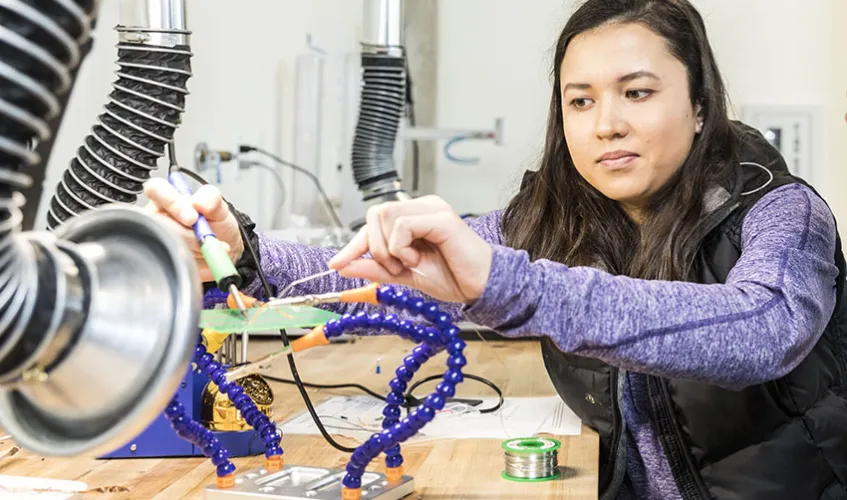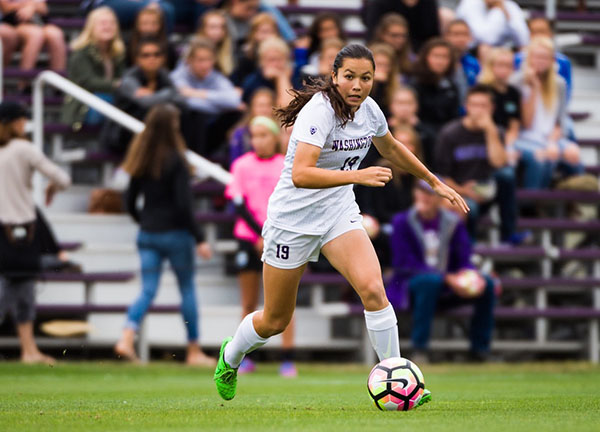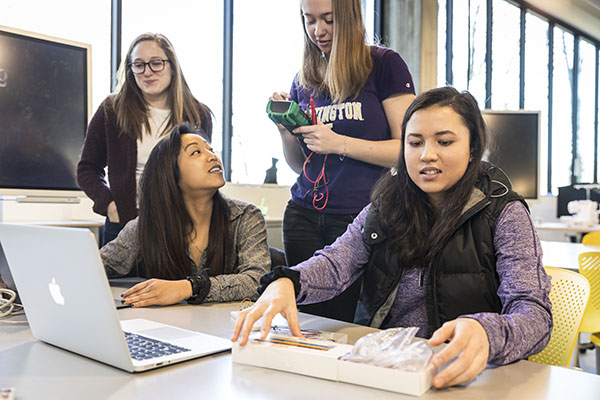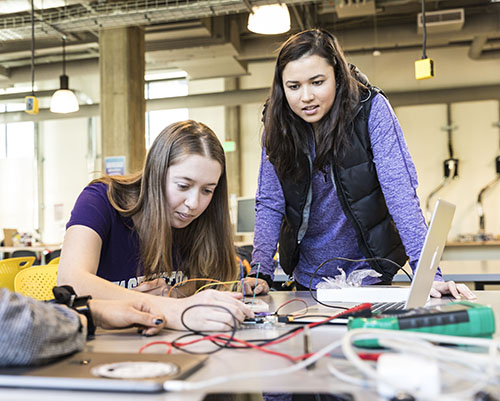Chelsea Yates

BioE senior Sam Kokoska solders circuit components to a circuit board at The MILL’s soldering station. Photo by Mark Stone / University of Washington
Having good balance gives soccer players an edge. It helps them maintain control of the ball, push past other players, change direction, and — if needed — recover. Good players understand that everything is in continual motion during play and maintaining a center of balance is critical.
These lessons apply as much to life off the field as on it, and they’re lessons that Sam Kokoska knows well. The bioengineering (BioE) senior has been on the UW Women’s Soccer team since arriving on campus in 2015. She’s been named to the Pac-12 All-Academic first team twice. Last year she was one of three finalists for the Arthur Ashe Sports Scholar of the Year Award, an honor recognizing student athletes nationwide who excel on the field, in the classroom and in the community.
This year — her senior year —a knee injury forced Kokoska to sit out the entire season. Instead of giving into frustration, she chose to pursue new opportunities. “Because of my injury, I’ve had more time to volunteer and develop leadership and teaching skills,” she says. “And that’s been great.”
We recently talked with Kokoska about making time for her many passions: engineering, soccer, mentoring and service.
The key to it all? Balance.

As a member of the UW Women’s Soccer team, Kokoska was named to the Pac-12 All-Academic first team twice and was one of three finalists for the Arthur Ashe Sports Scholar of the Year Award. Photo courtesy of Husky Athletics.
What led you to the UW and to BioE?
I wanted a school with a great soccer program and a strong commitment to academics. UW was the perfect match in the way it supports student success in athletics, academics, service and personal well-being. Husky Athletics is focused on the holistic development of student-athletes, and that’s very inspiring. I also love that there are many strong women leaders — including my coaches — across Athletics.
In addition to playing soccer, I wanted to study engineering and was interested in health care. At the UW, I learned about bioengineering. The idea of applying engineering solutions to medical problems immediately appealed to me.
Tell us about your BioE research interests.
I’m interested in engineering at the cellular and molecular levels. I worked in BioE professor Xiaohu Gao’s lab, where researchers focus on molecular engineering and imaging, nanotechnology and drug delivery. In addition to getting great hands-on research experience, I also learned about balancing priorities. When you’re excited about something, it’s easy to get caught up in it, and as much as I enjoyed lab research, I realized that I needed to figure out how to balance it with my commitments to coursework, soccer and service.
My senior capstone team project focuses on spinal fusion. With guidance from BioE professor Christopher Neils and UW Medicine neurosurgeon Dr. Rajiv Saigal, we’re investigating how engineering can help patients recover from spinal fusion surgery. Currently, patients use a bulky external device to stimulate bone growth after surgery, but it can be uncomfortable to wear and awkward to use. We’re developing a small, implantable electronic device to provide this stimulation in a novel way.

Kokoska’s BioE capstone team is developing a small, implantable electronic device to help stimulate bone growth in patience after spinal fusion surgery. From left to right: Taylor Monroe-Jones, Kai Ooi, Alexis Fleming and Sam Kokoska. Photo by Mark Stone / University of Washington.
Any similarities between soccer and engineering?
Both require a problem-solving mindset, and you need to work hard and smart at both. You also need to be curious, creative and analytical. But not too analytical — on the field, you don’t have a lot of time to assess and make decisions, so you need to bring confidence and a willingness to try. These traits are important in engineering, too.
You volunteer as a patient escort at UW Medicine and as a chemistry tutor at CLUE, the UW’s late-night multidisciplinary study center. Why do you make the time for these activities?
In Athletics we talk a lot about our Husky values, and a commitment to service is a big part of that. It’s also important to me personally. I’m motivated by service, and I try to give back every day. Tutoring has helped me teach and connect with others; explaining chemistry to students is a great way to keep my understanding sharp. Through my service work in patient care, I’ve become a better, more active listener, and I’ve learned a lot about empathy.
This year you served as an Engineering Peer Educator (EPE). What did that involve?
EPEs are experienced engineering students who help first-year engineering students transition into the UW Engineering community by serving as their E-FIG instructors and mentors. Because of my soccer injury, I had more time and since I enjoy tutoring, I applied to be a part of the EPE program.
This year there were about 50 EPEs from across the College, and during autumn quarter we led groups of about 20 first-year students. We taught weekly classes, managed lesson plans and grading, and facilitated discussions. We explained engineering curriculum, talked about the importance of diversity, and helped students understand different engineering fields and careers.
How has being an EPE enhanced your student experience?
It solidified my passion for teaching and helped me realize the impact I can have on others’ lives. I loved making connections with my students and helping them make connections with each other. It also challenged me to hone my time management and public speaking skills.

Fleming, left, and Kokoska, right, build and test electrical circuits for their device. Photo by Mark Stone / University of Washington.
Regarding balancing opportunities and responsibilities, what advice do you have for other students?
Prioritize what is most meaningful to you, and examine how you spend your time. For me this includes prioritizing self-care, paying attention to my needs and managing stress when it comes up. I may seem like I’m involved in a lot of activities, but they’re activities that I love. It’s important to enjoy what you’re doing and to have fun. It’s also important to take advantage of opportunities that come your way. My injury was unfortunate, but I still traveled with the team and served as a team leader. And it actually opened up time in my schedule to get involved in new activities, like the EPE program.
What’s next after graduation?
I’m applying to medical school. I think my engineering background will give me a unique perspective, and I’m excited to apply my engineering skills to medicine and patient care. I want my work to have an impact on people’s lives.
***
Learn more about UW Bioengineering and the College’s Engineering Peer Educator program.
Originally published March 18, 2019